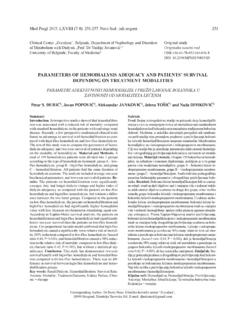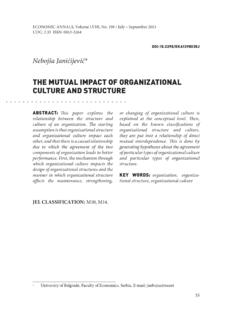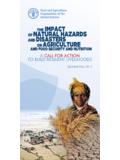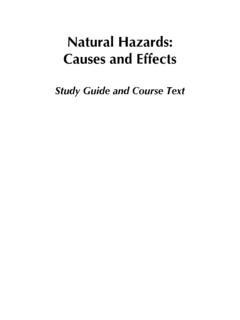Transcription of IMPORTANCE OF NATURAL DISASTER EDUCATION - CASE …
1 Available online at J. Geogr. Inst. Cvijic. 63(1) (75-88) Original scientific paper UDC: ( ) IMPORTANCE OF NATURAL DISASTER EDUCATION - CASE STUDY OF THE EARTHQUAKE NEAR THE CITY OF KRALJEVO- - First results- Milena Pani *1, Jelena Kova evi -Majki *, Dragana Miljanovi *, Radmila Mileti * * Geographical Institute Jovan Cviji SASA, Belgrade Received 21 November 2012; reviewed 03 December 2012; accepted 05 April 2013 Abstract: NATURAL disasters EDUCATION is a very important part in the prevention of NATURAL disasters. If it is applied from an early age, it would be successful and will yield positive results, namely to reduce the risks and consequences.
2 A good platform for the implementation of NATURAL disasters EDUCATION is the formal aspect of EDUCATION , precisely, subjects in elementary and secondary schools, including the geography as an interdisciplinary science which provides broad opportunities for understanding of all aspects of NATURAL disasters and thus plays an important role in preventing. Given the existing content of NATURAL disasters in the curriculum, as well as in geography textbooks in which mainly deal with NATURAL processes and partly their consequences, we conducted a survey of school-aged children which included checking of acquired knowledge, perception of risk of seismic hazard and response to a specific DISASTER .
3 Selected territory was the town of Kraljevo, which was hit by an earthquake magnitude on November 3rd 2010. The research was conducted through a survey testing of elementary school pupils. The questions are grouped into four segments: issues related to the activities and feeling of pupils "during an earthquake," feelings and activities "after the earthquake", "sources of knowledge about earthquakes" and "tipes of training they need." The results were analyzed by statistical methods, which have proven hypotheses relating to each of the above segments. They showed that only 12% of pupils responded correctly at the time of the earthquake, that 60% of pupils are not aware that their reaction was wrong during the earthquake, the earthquake has left a significant impression on the 61% of pupils and almost all pupils expressed an interest in training on appropriate behavior during disasters.
4 Key words: earthquake, city of Kraljevo, prevention, primary school pupils, geography. 1 Correspondence to: J. Geogr. Inst. Cvijic. 63(1) (75-88) 76 Introduction NATURAL disasters can have significant and sometimes catastrophic consequences for the population and the areas in which they live and work. The economic, social and environmental effects can impinge on economic developments, lifestyle, emotional and psychological well-being of humans and animals leading to disfunction of human society and degradation of NATURAL resources. The extent of the damage depends on the intensity and frequency of NATURAL hazards , and vulnerability of elements of the affected areas (population, buildings, infrastructure, etc.)
5 Therefore, predicting the hazard event, and strengthening the resilience of people and property, significantly reduces the negative impact of hazards ; by influencing one of the two factors, it is possible to reduce the risks, as described by the Pressure and Release (PAR) model (Wisner, Blaikie, Cannon & Davis, 2004). Since some NATURAL processes are still largely unpredictable ( earthquakes) the focus is placed on reducing the vulnerability of the population. In view of the above facts, since the 80-'s of the 20th century, risk and vulnerability assessment gained strategic IMPORTANCE in the process of risk reduction, which is taken as an important component of the general policy of every country (ISDR, 2008).
6 In order to mitigate the consequences of NATURAL disasters it is necessary to build resilience of the society, which is achieved through prevention. In this context, the Hyogo Framework2 for the 2005-2015 period a program of actions for NATURAL DISASTER risk reduction has defined five priority actions, of which one involves the use of knowledge, innovation and EDUCATION to build a culture of security and resilience at all levels (Hyogo , 2005). Numerous studies have shown that the number of victims and those injured in NATURAL disasters is far less if the community is aware of the risks, if the members of the community are informed about NATURAL disasters and have correct behaviour under these circumstances (Morrissey, 2007; King & Gurtner, 2005).
7 From the above, it follows that the role of EDUCATION in prevention is multiple, especially if it focuses on children. EDUCATION is a platform for building a culture of prevention and resilience of the community3. EDUCATION of children fulfills two 2 Hyogo Framework for Action 2005-2015: Building the Resilience of Nations and Communities to Disasters 3 Name of the UNISDR campaign DISASTER Risk Reduction Begins at School (2006-2007) and publications which are parts of it (Let Our Children Teach Us! A Review of the Role of EDUCATION and Knowledge in DISASTER Risk Reduction; 2006; Lessons for life - Building a culture of safety and resilience to disasters through schools, 2006; Towards a Culture of Prevention: DISASTER Risk Reduction Begins at School - Good Practices and Lessons Learned, 2007) point to the IMPORTANCE of the school as institution and EDUCATION in NATURAL DISASTER prevention.
8 IMPORTANCE of NATURAL DISASTER EDUCATION case study of the earthquake near the city of Kraljevo - 77important goals: it lasts a lifetime, and the children pass their knowledge on to parents and community members. Not surprisingly, Stoltman, Lidstone & Dechani (2007) call them "teachers at home and in the community," as confirmed by Finnis, Standring, Johnston, & Ronan (2004) who identified them as the holders of EDUCATION with the ability to educate people around. Schools are an important link between children, families and the community in the process of preparing for unexpected events that may occur due to NATURAL hazards of higher intensity (Johnston et al.)
9 , 2011); children learn at school about NATURAL processes and may recognize the indicators of impending NATURAL disasters. A clear example is a ten-year old girl, Tilly Smith who thanks to her geography classes where she learnt how to identify the signs of an oncoming tsunami rescued about 100 people in Thailand, in 2004 (King & Gurtner, 2005). An important goal of the EDUCATION about NATURAL DISASTER risk reduction is to convey a positive attitude and respect for the environment in general; the information that surrounds us, and is related to the above topics, does not necessarily lead to the EDUCATION of the population, and changes in behaviour.
10 More specifically, EDUCATION about NATURAL disasters should provide not only information, but also thorough understanding of the issues, as well as attitudes and skills that will enable adequate response in a crisis. In such an approach, formal EDUCATION represents the basis on which the teachers should build further: transform information into knowledge and ideas into action (Murdoch, 2007). DISASTER risk EDUCATION is defined as the transfer of general (thematic, organizational, technical) knowledge and skills about NATURAL disasters and risks from the professionals in the relevant institutions (schools, courses), to pupils or trainees (Kuhlicke, 2011).



















